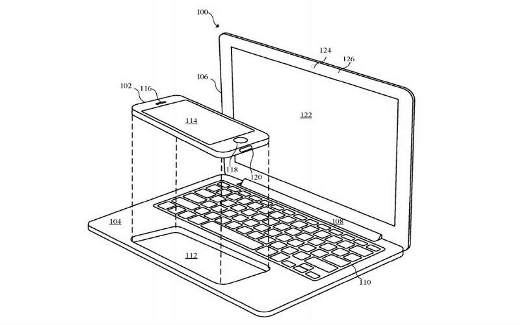The Future Unveiled: Apple Patents a Laptop that Merges with the Smartphone

Introduction:
In a groundbreaking move that pushes the boundaries of technological convergence, Apple has recently been granted a patent for a laptop that seamlessly merges with a smartphone. This innovative concept has the potential to redefine the way we interact with our devices, blurring the lines between laptops and smartphones. In this comprehensive exploration, we delve into the details of Apple’s patented technology, its potential implications, and how this convergence could shape the future of personal computing.
I. Apple’s Vision: A Laptop-Smartphone Hybrid
- The Patent Overview:
- Apple’s patent describes a transformative concept where a laptop and a smartphone can physically connect and operate as a single, unified device.
- The patent outlines a mechanism that allows the smartphone to dock into the laptop, serving as the laptop’s touchpad, processing unit, or additional display.
- Seamless Integration:
- Apple envisions a seamless integration between the laptop and the smartphone, where users can effortlessly transition between standalone smartphone use and a combined laptop-smartphone experience.
- Versatility and Efficiency:
- The patented technology aims to enhance the versatility and efficiency of personal computing by leveraging the capabilities of both devices in a harmonious manner.
II. Technical Aspects of the Patent:
- Docking Mechanism:
- The patent details a docking mechanism that allows the smartphone to securely connect to the laptop.
- This docking mechanism could involve magnetic connections, USB-C, or other proprietary connectors that facilitate a stable physical link.
- Shared Resources:
- The patent hints at the possibility of shared resources, enabling the laptop to utilize the smartphone’s processing power, storage, and other functionalities.
- User Interface Integration:
- Apple envisions a user interface that seamlessly transitions between the laptop and smartphone modes, providing a unified experience.
III. Potential Implications for Users:
- Streamlined Workflow:
- Users may experience a more streamlined workflow as tasks initiated on the smartphone can seamlessly transition to the laptop and vice versa.
- Enhanced Portability:
- The convergence of a laptop and smartphone could lead to enhanced portability, as users may choose to carry only their smartphones while having the option to transform it into a full-fledged laptop when needed.
- Optimized Power Efficiency:
- Leveraging the smartphone’s processing power for less resource-intensive laptop tasks could lead to optimized power efficiency, potentially extending battery life.
IV. Challenges and Considerations:
- Technical Challenges:
- Implementing a seamless integration of two distinct devices poses technical challenges, including compatibility issues, synchronization, and ensuring a smooth user experience.
- Security and Privacy:
- Combining the functionalities of a laptop and smartphone raises concerns about data security and privacy. Addressing these issues will be crucial for user trust and adoption.
- Market Dynamics:
- The success of such a revolutionary concept depends on market dynamics, including user acceptance, competition, and the overall evolution of personal computing trends.
V. The Evolution of Convergence:
- Historical Context:
- The idea of convergence is not new, with previous attempts to merge different devices such as laptops and tablets, or smartphones and desktops.
- Apple’s approach builds upon this historical context, aiming for a more seamless and integrated convergence.
- Shift in User Expectations:
- As user expectations evolve, there is a growing demand for devices that offer flexibility, adaptability, and a cohesive user experience across various computing scenarios.
VI. The Future Landscape of Personal Computing:
- Era of Hybrid Devices:
- Apple’s patented technology signals a potential shift towards a new era of hybrid devices that transcend traditional form factors.
- Users may witness an increased convergence of devices, blurring the lines between laptops, tablets, and smartphones.
- Innovation and Competition:
- Apple’s move highlights the ongoing innovation and competition within the tech industry, as companies strive to redefine and enhance the user experience.
VII. Conclusion:
The patent for a laptop that merges with a smartphone marks a significant milestone in the evolution of personal computing. Apple’s visionary approach towards convergence has the potential to reshape the landscape of devices we use daily. As this technology progresses from the realm of patents to tangible products, users can anticipate a future where the boundaries between laptops and smartphones blur, offering a seamless and dynamic computing experience. The journey towards this convergence promises to be an exciting exploration of innovation, technical challenges, and the ever-evolving expectations of users in the digital era.




